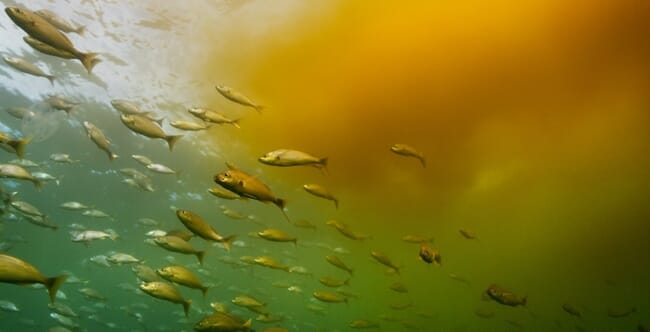So argues a team of researchers from UC Santa Barbara, in a study in the journal Marine Policy.
“A key goal of conservation ecology is to understand and maintain the natural balance of ecosystems, because human activity tends to tip things out of balance,” co-author Darcy Bradley, co-director of UCSB’s Ocean and Fisheries Program, said in a news release.
Activities like industrial-scale farming send lots of nutrients into the ocean, where they cause massive algal blooms. While these algae produce oxygen when they’re alive, they die so suddenly and in such volume that their rapid decomposition consumes all the available oxygen in the water, creating dead zones.

© UCSB
However, cultivated seaweed could draw down available nutrients, the authors claim, limiting the resources for unchecked growth of nuisance algae and microbes. Seaweeds also produce oxygen, which could alleviate the development of hypoxic dead zones.
In the study, the authors analysed data from the Gulf of Mexico. More than 800 watersheds across 32 states deliver nutrients to the Gulf, which has led to a growing low-oxygen dead zone. In 2019, this dead zone stretched just over 18,000 square kilometres.
Using open-source oceanographic and human-use data, the team identified areas of the gulf suitable for seaweed cultivation. They found roughly 9 percent of the United States’ exclusive economic zone in the gulf could support seaweed aquaculture, particularly off the west coast of Florida.
“Cultivating seaweed in less than 1 percent of the US Gulf of Mexico could potentially reach the country’s pollution reduction goals that, for decades, have been difficult to achieve,” said lead author Phoebe Racine, a PhD candidate at UCSB’s Bren School of Environmental Science & Management.
“Dealing with nutrient pollution is difficult and expensive,” Bradley added. The US alone spends more than $27 billion every year on wastewater treatment.
Many regions employ water quality trading programmes to manage this issue. In these cap-and-trade systems regulators set a limit on the amount of a pollutant that can be released, and then entities trade credits in a market. Water quality trading programmes exist all over the US, though they are often small, bespoke and can be ephemeral. That said, they show a lot of promise and, according to Racine, have bipartisan support.
Seaweed aquaculture would fit nicely within these initiatives. “Depending on farming costs and efficiency, seaweed aquaculture could be financed by water quality trading markets for anywhere between $2 and $70 per kilogram of nitrogen removed,” Racine said, “which is within range of observed credit prices in existing markets.”
What’s more, the researchers note that demand is rising for seaweed in food and industry sectors. Potential products include biofuel, fertilizer and food, depending on the water quality, Racine said. This means that, unlike many remediation strategies, seaweed aquaculture could pay for itself or even generate revenue.
“The US has traditionally had a lot of barriers to getting aquaculture in the ocean,” Bradley explained. “But there is mounting political support in the form of drafted bills and a signed executive order that could catalyze the expansion of the US aquaculture industry.”
Further research
This study is the first of several to come out of the Seaweed Working Group, an interdisciplinary body of researchers looking to understand and chart the potential of seaweed aquaculture’s benefits to society.
The group is currently investigating a range of other ecosystem services that seaweed cultivation could provide, such as benefits to surrounding fisheries and carbon capture.
A longer version of this article, by Harrison Tasoff, was first published in UCSB's The Current.


